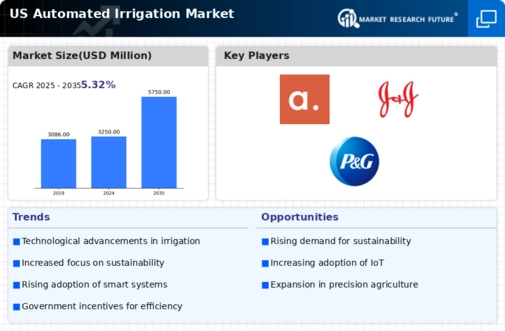The automated irrigation market is currently characterized by a dynamic competitive landscape, driven by technological advancements and increasing demand for efficient water management solutions. Key players such as Rain Bird Corporation (US), Hunter Industries (US), and Toro Company (US) are at the forefront, each adopting distinct strategies to enhance their market positioning. Rain Bird Corporation (US) emphasizes innovation in smart irrigation technologies, focusing on developing systems that integrate with IoT devices to optimize water usage. Meanwhile, Hunter Industries (US) has been expanding its product portfolio to include more sustainable solutions, reflecting a growing consumer preference for environmentally friendly practices. Toro Company (US) is actively pursuing partnerships with agricultural technology firms to enhance its digital offerings, thereby positioning itself as a leader in precision irrigation solutions.
The business tactics employed by these companies reveal a trend towards localizing manufacturing and optimizing supply chains to reduce costs and improve service delivery. The market appears moderately fragmented, with several players competing for market share while also collaborating on technological advancements. This competitive structure allows for a diverse range of products and services, catering to various segments within the automated irrigation market.
In November 2025, Rain Bird Corporation (US) announced the launch of its new line of smart irrigation controllers, which utilize AI algorithms to adapt watering schedules based on real-time weather data. This strategic move is likely to enhance the company's competitive edge by offering customers a more efficient and user-friendly solution, thereby addressing the increasing demand for smart home technologies in irrigation.
In October 2025, Hunter Industries (US) unveiled its latest sustainable irrigation system designed for commercial landscapes, which incorporates recycled water usage. This initiative not only aligns with global sustainability goals but also positions the company as a pioneer in eco-friendly irrigation solutions, potentially attracting environmentally conscious consumers and businesses.
In September 2025, Toro Company (US) entered into a strategic partnership with a leading agricultural technology firm to develop integrated irrigation management software. This collaboration is expected to enhance Toro's capabilities in precision agriculture, allowing farmers to optimize water usage and improve crop yields, thus reinforcing its market position in the agricultural sector.
As of December 2025, the competitive trends within the automated irrigation market are increasingly defined by digitalization, sustainability, and the integration of AI technologies. Strategic alliances among key players are shaping the landscape, fostering innovation and enhancing product offerings. The shift from price-based competition to a focus on technological advancement and supply chain reliability is evident, suggesting that future competitive differentiation will hinge on the ability to innovate and adapt to evolving consumer preferences.














Leave a Comment